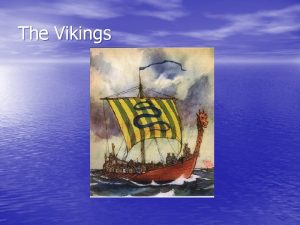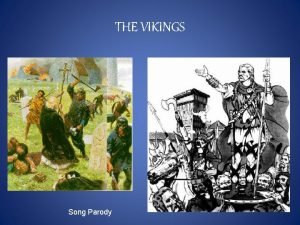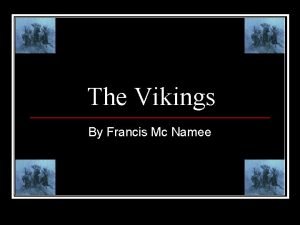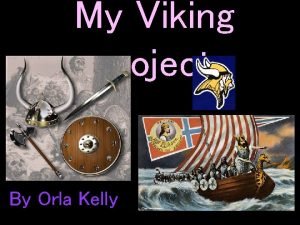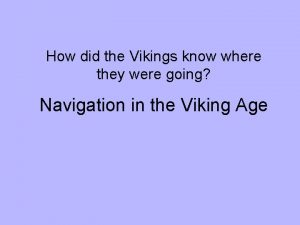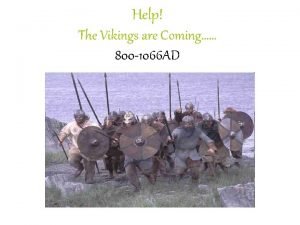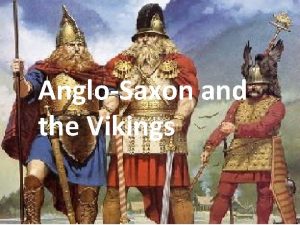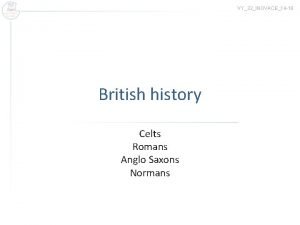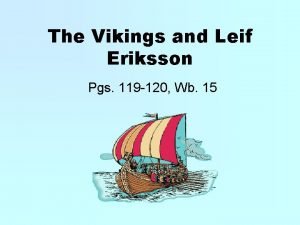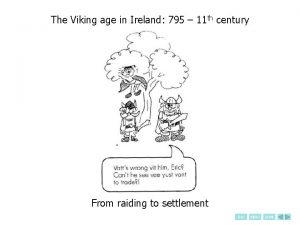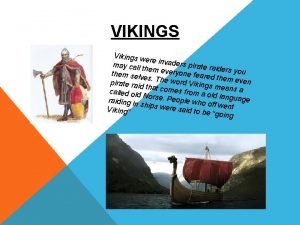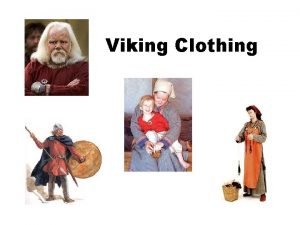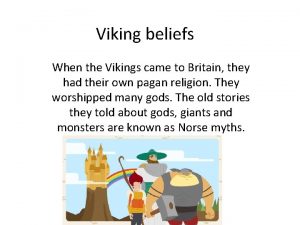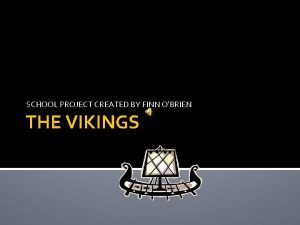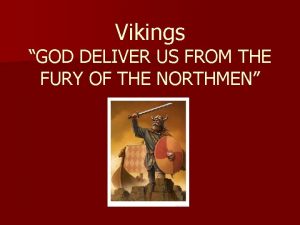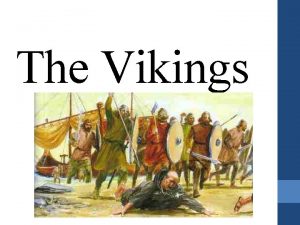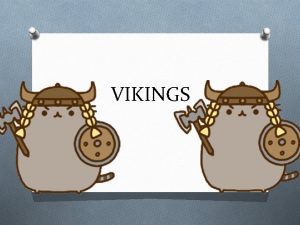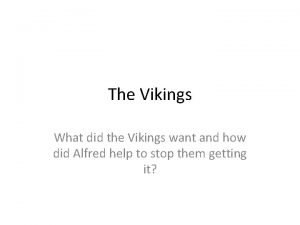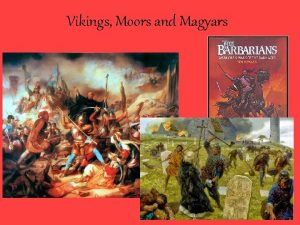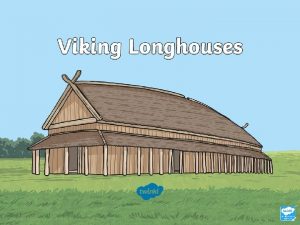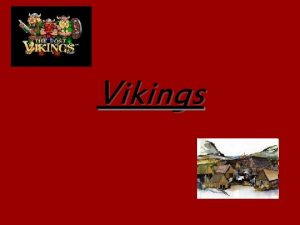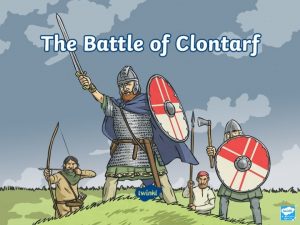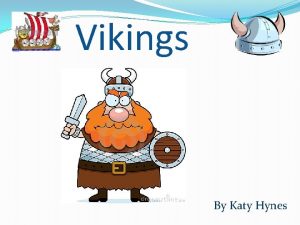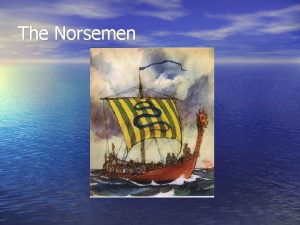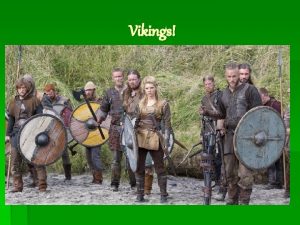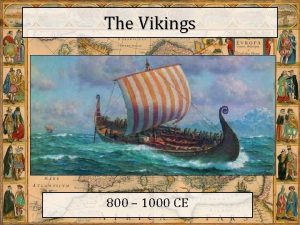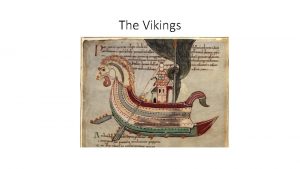Vikings and Their Influence Vikings and Their Influence































- Slides: 31

Vikings and Their Influence

Vikings and Their Influence • By the end of the eighth century, England was the most prosperous country in Europe. The coincidence of the medieval warming period and the separation of the island from some of the continental wars allowed an unprecedented level of intellectual and artistic growth as well as economic development. • But in 793, the Vikings, marauders from Scandinavia, sacked and burned the monastery of Lindisfarne, beginning a century of destruction and cultural collapse.

The strength of Vikings • The Vikings were possessed of superior technology and military organization, and their warbands ravaged England (and much of the rest of Europe). • At first the attacks were small-scale, leading to the destruction of individual monasteries, but in 850, large Danish fleets began to arrive in England, and the Vikings began to conquer as well as pillage. • Eventually almost all of northern and eastern England was under their control, with York (Jarvik) and Dublin in Ireland being major Viking centers of control.

• The resistance from the English was badly organized and often ineffective. The lack of unity in England made it a great deal easier for the Vikings to roam and raid the countryside. • The Vikings, usually referred to as ‘Danes’, successfully took control of large parts of England, and towards the end of the ninth century their eyes turned to Wessex, the strongest of the Saxon kingdoms not yet under Danish control.


Conquering England In the 870 s it looked as if the Vikings would completely conquer England. Alfred, the king of Wessex, was reduced to skulking in the Somerset marshes with a small band of men. But Alfred was able to rally his kingdom and defeat the Vikings at the battle of Edington. This led to a treaty between the Viking Guthrum and Alfred in which, among other things, Guthrum agreed to be baptized and Alfred recognized that the Danes would stay in England (though outside of his areas of control).

Bayeux Tapestry: harold rex interfectus est (King Harold gets killed)

Conquering England • Alfred and the Viking leader Guthrum reached an agreement, called the Treaty of Wedmore, where the Vikings promised to leave Wessex alone and to accept Christianity.


• The northern and eastern counties already belonged to the Danes, and now a southern boundary was drawn. This area was what would be called the Danelaw.

Distribution of place names with Scandinavian origins and the Danelaw


Cultural Integration • Although there were massacres on occasion, in general the English and the Danesin the Danelaw thoroughly mixed with each other, both through intermarriage and in culture. The conversion of Guthrum to Christianity meant that the religion of the Danes and the English in England was the same, leading to greater cultural integration. In addition, the language of the Vikings was a North Germanic language and possibly was understandable to the people who spoke the Anglian dialect of Old English—a West Germanic language. Most of the English in the Danelaw were Anglian speakers.

• Naturally, the massive migration and settlement that the Scandinavians undertook led to extensive use of the Norse (Scandinavian) tongue in the area of the Danelaw, and we can see evidence of it even today through its influences on the English language.

Similarity in Anglo-Saxons and Vikings • The Anglo Saxons and the Vikings were culturally quite similar. They spoke similar languages and had similar traditions and it appears that the Vikings soon started integrating with the Anglo Saxons.

All languages borrow words from other languages, but English has been especially prolific in its adoption of new words from outside sources. Even at the very beginning, when the Anglo-Saxons were an obscure group of continental “barbarians” at the fringes of the Roman Empire, a few Latin words managed to work their way into Old English. We recognize these particular words because they underwent the same sound-shifts as did native words. We surmise that the Anglo-Saxons took names from the Romans for things that they did not have in their own culture, in particular items of trade.

Thus we find “win” (“wine, ” from Latin “vinus”; this word was borrowed again later, which is why “wine, ” which is consonant-shifted, comes from a “vineyard, ” which is not), “ceap” (“bargain, ” the origin of our Modern English “cheap”; Old English “c” before front vowels is pronounced “ch”), “linen, ” “cires” (cherry), “popig” (poppy; Old English “g” before and after front vowels is pronounced “y”), “cytel” (kettle), “pyle” (which becomes pillow), “gimm” (gem), “butere” (butter), “cealc” (chalk), and “copper. ”

The Anglo-Saxons also borrowed words for war, including “camp” (battle, later evolving to place of battle and then our modern meaning), “weall” (wall, fortification), “pytt” (pit), “strat” (street), and “segn” (banner, later sign). A few of the remaining words that are most interesting are “draca” (dragon; the native Old English word was “wyrm”), “cirice” (church), “bisceop” (bishop), and even “Saternesdag” (Saturn’s day, i. e. , Saturday). From these words we can even reconstruct some of the culture of the Anglo-Saxon tribes on the continent: They traded with the Romans, fought with the Romans, and were influenced by some Roman customs and institutions.

Influence on English The influence of Scandinavian on English was enormous. Not only were hundreds of individual nouns, verbs, and adjectives borrowed (as they had been, in smaller numbers, from Latin), but the pronouns, prepositions, adverbs, and even a form of the verb “to be” were incorporated from the language of the Danes. This kind of transference of these kinds of parts of speech is very rare historically. The pronouns “they” and “them” are Scandinavian, as is the word “are” (the standard Old English plural for “to be” was “syndon”). Prepositions “to, ” “fro, ” and the conjunction “though” were borrowed from the Danes as well.

Influence on Grammar In terms of grammar, using “-s” in the third person singular, present indicative form of verbs (“he walks, ” “she thinks”) comes from Scandinavian. But far more significant was the influence of the Scandinavian languages on the inflectional system of Old English. There were many, many words in common between Old English and the language of the Danes (man, wife, father, mother, winter, summer, smile, ride, stand, set, spin, over, under, and many more); the major differences between words would be in the different endings added to them for grammatical purposes.

Speakers of Old English and Scandinavian could thus more easily understand each other if they stripped away the inflections and relied upon other cues, most significantly word order, to indicate grammatical relationships. This reduction or elimination of the inflectional system was a major step toward modifying English from a synthetic language to the analytic language it is today (although it was the Norman Conquest that dealt the final blow to the inflectional system).

Scandinavian Vocabulary • Scandinavian vocabulary penetrated nearly every area of the English language, but most words of Scandinavian origin in English are concrete everyday words. A few examples follow here: o Nouns: bank, birth, booth, egg, husband, law, leg, root, score, sister, skin, trust, wing and window

o Adjectives awkward, flat, happy, ill, loose, low, odd, sly, ugly, weak, and wrong o Verbs to cast, clip, crawl, cut, die, drown, gasp, give, lift, nag, scare, sprint, take, and want. And of course the present plural of ‘to be’, are. o Pronouns both, same, they, them and their

• The fact that even the Norse pronouns ‘they’, ‘them’ and ‘their’ were accepted into English is remarkable; it is very unusual that grammatical items are borrowed. • This suggests that there was extensive contact between the Anglo Saxons and the Vikings and a gradual integration of the two groups.

• It can be difficult to recognize the Scandinavian words since the languages are so closely related; many words that look Scandinavian are actually native English words.

The Hints to identify Scandinavian Loan • Here are some hints on how to decide whether a word is a Scandinavian loan or not: 1. Germanic /sk/ became / ʃ / (sh) in all positions. This change occurred later in Scandinavia, and therefore words like shall, shoulder and shirt are native English words whereas skin, sky and skirt are Scandinavian words. 2. In early Old English the Germanic /g/ before front vowels became /j/, and /k/ became /ʃ /. In Old Norse /g/ and /k/ remained. Thus, child, choose and yield are all native words, while give, gift, kid and kindle are Scandinavian.

3. Date of first appearance. For instance, the Old English word for ‘take’ was niman, but in late Old English tacan is found. The Old Norse word was taka, which shows that it must have been borrowed from the Scandinavians. In the same way, the word for ‘law’ was originally æ but a later recording is lagu, which comes from Old Norse.

Scandinavian words in Legal Area • In fact, judging by the large number of Scandinavian words in the legal area, The Vikings had a considerable impact upon the law and order of the Anglo-Saxons. • Some examples are fellow (‘partner’), law, and outlaw.

• Even more Scandinavian words related to the legal area existed in Old English but were later replaced. • Not only did the Scandinavian peoples bring their laws and customs to the Danelaw, but their view on law and legal custom was to a great extent acknowledged by all of England.

To Conclude Even before the cataclysm of the Norman Conquest, England was well on its way toward evolving into its modern form as an analytic (rather than synthetic language) that promiscuously borrowed words from nearly any source. But all of the changes we have thus discussed, even the influence of Scandinavian languages, have been evolutionary. The events of 1066 were to prove revolutionary and would change English forever.

Summary • • The Strength of Vikings Conquering England Traces of Cultural Integration Its Influence on English language Scandinavian Vocabulary Hints to identify Scandinavian Loan Words Conclusion
 What vikings drank
What vikings drank Mongols vs vikings
Mongols vs vikings Scandinavian explorers
Scandinavian explorers Nn budding
Nn budding Vikings land
Vikings land The vikings were sailors came
The vikings were sailors came Where did vikings originate from
Where did vikings originate from Nn vikings
Nn vikings Where did the vikings go
Where did the vikings go Viking love song
Viking love song Vikings mc norway
Vikings mc norway Vikings soccer club
Vikings soccer club Where did the vikings originate from
Where did the vikings originate from How did the vikings know where they were going
How did the vikings know where they were going Danelaw area
Danelaw area Anglo saxon days of the week
Anglo saxon days of the week Celts romans anglo saxons vikings normans
Celts romans anglo saxons vikings normans Vikings region
Vikings region Viking ship anatomy
Viking ship anatomy Vikings eriksson
Vikings eriksson Vikings in ireland timeline
Vikings in ireland timeline “how did the vikings change medieval europe?”
“how did the vikings change medieval europe?” When did the vikings stop raiding
When did the vikings stop raiding Pirate bay vikings
Pirate bay vikings Vikings sack paris
Vikings sack paris Vikings dress code
Vikings dress code Viking beliefs
Viking beliefs Vikings slsc
Vikings slsc Viking children clothes
Viking children clothes Finn vikings
Finn vikings From the fury of the northmen deliver us
From the fury of the northmen deliver us Pirate bay competitors
Pirate bay competitors




